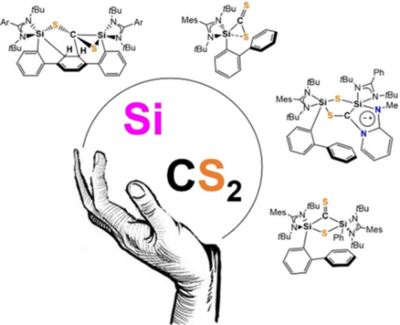A Striking Mode of Activation of Carbon Disulfide with a Cooperative Bis(silylene)
Marcel-Philip Luecke, Luisa Giarrana, Arseni Kostenko, Tobias Gensch, Shenglai Yao, Matthias Driess
The activation of molecules is a key step in catalysis. Activating small molecules such as O2, NH3, H2 CO2 or CS2 is very important since it offers numerous possibilities to synthesize selectively functional organic compounds. Typically, such small molecules are activated employing transition metals. In the past decade, however, it has been found that low-valent main group element compounds such as silylenes are also able to activate small molecules. The characterization of the underlying activation modes is an active area of research. A detailed understanding of the activation of small molecules is essential for the development of improved catalysts – one of the goals of UniSysCat.
The current study reports on the activation of carbon disulfide (CS2) with a bis(silylene). The research team involving UniSysCat group leaders Prof. Matthias Driess and Dr. Tobias Gensch from TU Berlin found that the metal-free activation mode observed is completely different from activation with a monosilylene.
CS2 is a heavy chalcogen homologue of CO2. It is used for the industrial production of viscose fibers from cellulose and as a precursor for the synthesis of CCl4 and thiourea in large quantities. Furthermore, CS2 is a convenient building block for C,S-containing compounds in organic chemistry.
For the activation of small molecules like CS2, bis(silylenes) turned out to be promising candidates: Bridged bis(N-heterocyclic silylenes) with two silylene moieties present in a single molecule have successfully been employed in metal-free cooperative activation of small molecules. They also act as electron-rich donors in metal-mediated homogeneous catalysis. On their search for new activation pathways, the UniSysCat research team now studied the activation behavior of a certain bis(silylene), namely 1,4-substituted bis(silylenyl)terphenylene, towards CS2. The authors wondered whether the two silylene groups in this specific bis(silylene) were cooperative in the activation of CS2.
Their combined experimental and theoretical approach revealed that the activation of CS2 with the 1,4-terphenyl supported bis(silylene) proceeds quite unexpectedly: via dearomatization of the phenylene ring. Indeed, this result shows an unexpected new type of cooperativity of the two silicon(II) atoms in this bis(silylene). According to DFT calculations, a transient silene containing a Si=C bond capable of π(C=C) addition at the aromatic phenylene ring is a key intermediate. In contrast, the addition of CS2 to the studied monosilylene (biphenyl-substituted monosilylene ortho-(LSi)C6H4-C6H5) leaves the aromatic π-system intact.
The current study demonstrates the high potential of mono- and bis-silylenes in generating multifunctional organosulfur species which are difficult to access by other routes.
The findings of Luecke et al. have been published in an open access article in Angwandte Chemie chosen as a Hot Paper: Luecke, M.-P., Giarrana, L., Kostenko, A., Gensch, T., Yao, S. and Driess, M. (2021), A Striking Mode of Activation of Carbon Disulfide with a Cooperative Bis(silylene). Angew. Chem. Int. Ed. https://doi.org/10.1002/anie.202110398

